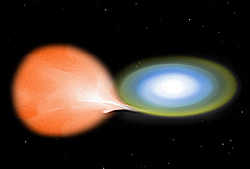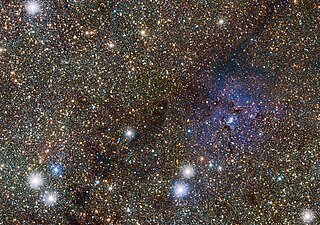A PG 1159 star, often also called a pre-degenerate, [1] is a star with a hydrogen-deficient atmosphere that is in transition between being the central star of a planetary nebula and being a hot white dwarf. These stars are hot, with surface temperatures between 75,000 K and 200,000 K, [2] and are characterized by atmospheres with little hydrogen and absorption lines for helium, carbon and oxygen. Their surface gravity is typically between 104 and 106 meters per second squared. Some PG 1159 stars are still fusing helium. [3] , § 2.1.1, 2.1.2, Table 2. The PG 1159 stars are named after their prototype, PG 1159-035. This star, found in the Palomar-Green survey of ultraviolet-excess stellar objects, [4] was the first PG 1159 star discovered.

A star is an astronomical object consisting of a luminous spheroid of plasma held together by its own gravity. The nearest star to Earth is the Sun. Many other stars are visible to the naked eye from Earth during the night, appearing as a multitude of fixed luminous points in the sky due to their immense distance from Earth. Historically, the most prominent stars were grouped into constellations and asterisms, the brightest of which gained proper names. Astronomers have assembled star catalogues that identify the known stars and provide standardized stellar designations. However, most of the estimated 300 sextillion (3×1023) stars in the Universe are invisible to the naked eye from Earth, including all stars outside our galaxy, the Milky Way.

Hydrogen is a chemical element with symbol H and atomic number 1. With a standard atomic weight of 1.008, hydrogen is the lightest element in the periodic table. Hydrogen is the most abundant chemical substance in the Universe, constituting roughly 75% of all baryonic mass. Non-remnant stars are mainly composed of hydrogen in the plasma state. The most common isotope of hydrogen, termed protium, has one proton and no neutrons.

A planetary nebula, abbreviated as PN or plural PNe, is a type of emission nebula consisting of an expanding, glowing shell of ionized gas ejected from red giant stars late in their lives.
It is thought that the atmospheric composition of PG 1159 stars is odd because, after they have left the asymptotic giant branch, they have reignited helium fusion. As a result, a PG 1159 star's atmosphere is a mixture of material which was between the hydrogen- and helium-burning shells of its AGB star progenitor. [3] , §1. They are believed to eventually lose mass, cool, and become DO white dwarfs. [2] ; [5] , §4.

The asymptotic giant branch (AGB) is a region of the Hertzsprung–Russell diagram populated by evolved cool luminous stars. This is a period of stellar evolution undertaken by all low- to intermediate-mass stars late in their lives.

In nuclear chemistry, nuclear fusion is a reaction in which two or more atomic nuclei are combined to form one or more different atomic nuclei and subatomic particles. The difference in mass between the reactants and products is manifested as either the release or absorption of energy. This difference in mass arises due to the difference in atomic "binding energy" between the atomic nuclei before and after the reaction. Fusion is the process that powers active or "main sequence" stars, or other high magnitude stars.
Some PG 1159 stars have varying luminosities. These stars vary slightly (5–10%) in brightness due to non-radial gravity wave pulsations within themselves. They vibrate in a number of modes simultaneously, with typical periods between 300 and 3,000 seconds. [6] [7] , Table 1. The first known star of this type is also PG 1159-035, which was found to be variable in 1979, [8] and was given the variable star designation GW Vir in 1985. [9] These stars are called GW Vir stars , after their prototype, or the class may be split into DOV and PNNV stars. [7] , § 1.1; [10]

In fluid dynamics, gravity waves are waves generated in a fluid medium or at the interface between two media when the force of gravity or buoyancy tries to restore equilibrium. An example of such an interface is that between the atmosphere and the ocean, which gives rise to wind waves.

The second is the base unit of time in the International System of Units (SI), commonly understood and historically defined as 1⁄86400 of a day – this factor derived from the division of the day first into 24 hours, then to 60 minutes and finally to 60 seconds each. Analog clocks and watches often have sixty tick marks on their faces, representing seconds, and a "second hand" to mark the passage of time in seconds. Digital clocks and watches often have a two-digit seconds counter. The second is also part of several other units of measurement like meters per second for velocity, meters per second per second for acceleration, and per second for frequency.










